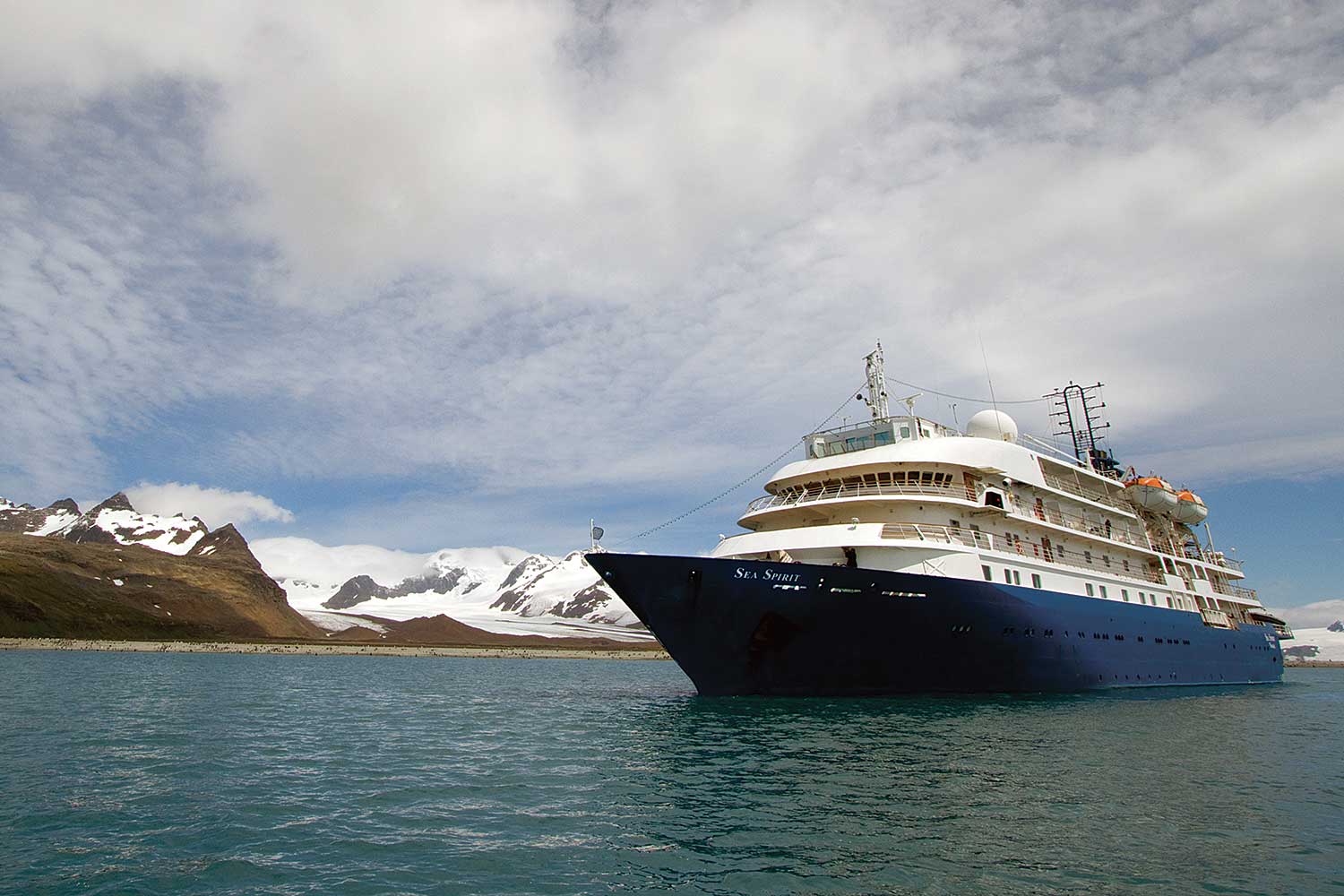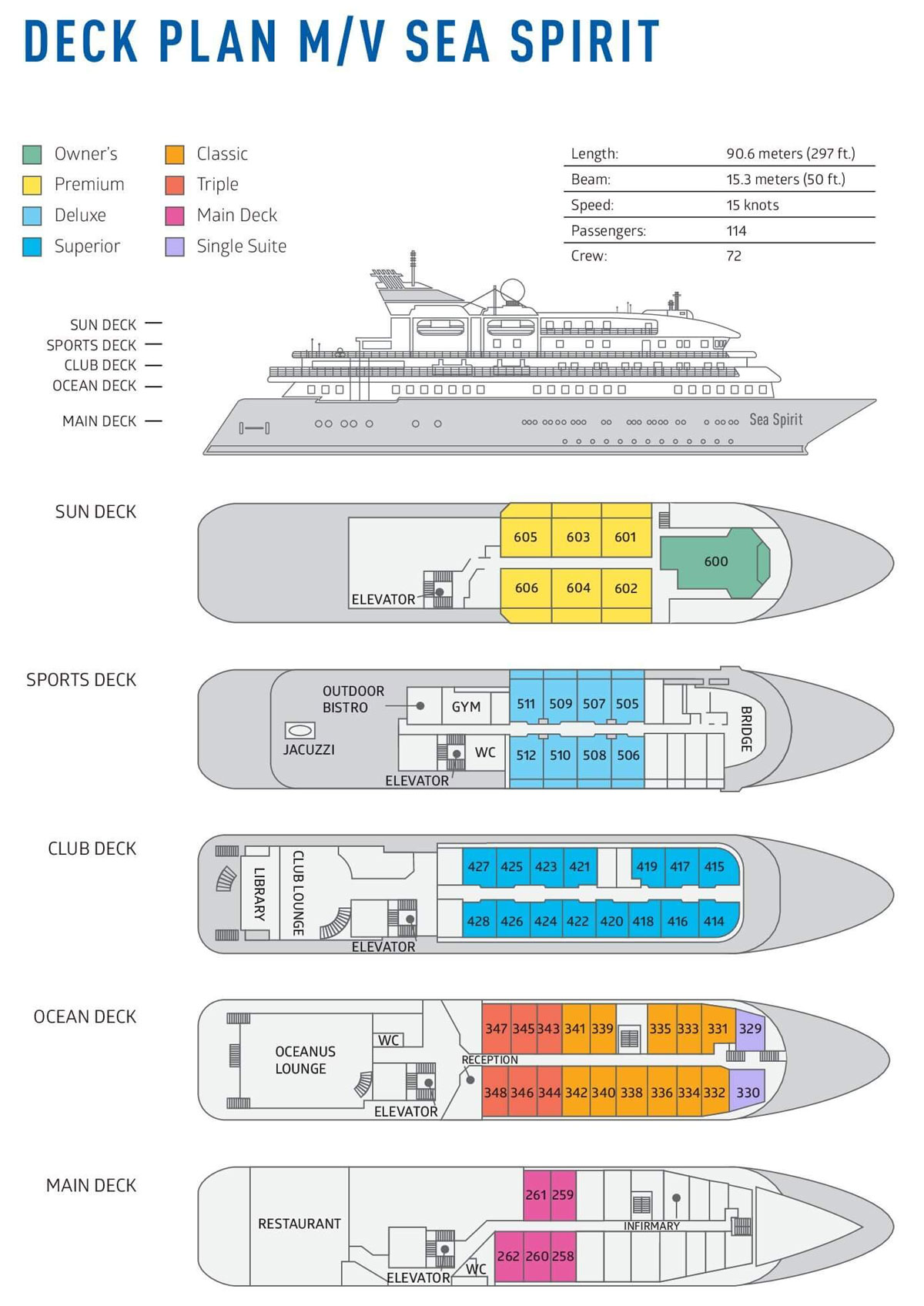Svalbard Circumnavigation Kvitøya: Sea Spirit
Arctic
Participate in polar bear photo-safari cruise in continuous Arctic daylight. Discover seals and whales amongst the Arctic pack ice as we explore far above the Arctic Circle – only 600 miles from the North Pole. The mountains of Svalbard provide a continuous, spectacular backdrop and the expedition reaches all the way to seldom-visited, glacier capped White Island. All this in exclusive comfort on board the luxurious M/V Sea Spirit
- Spectacular coasts, fjords and glaciers of Spitsbergen
- Reach the Polar pack ice of the North and Northeast coasts
- Arctic wildlife such as polar bears, walrus and seals
- Huge concentrations of birdlife
- The luxury expedition vessel Sea Spirit
Super Early Bird 2025
*Super Early Bird Prices 2025 Season (15% reduced for Triple, Main Deck, Single and Classic Suites; 20% for Superior, Deluxe, Premium, and Owner’s Suites) are now in place for all new bookings confirmed by June 30, 2024. Discounted prices as shown.
Stewart's Take
The ultimate peak-season Svalbard expedition cruise!
Overview
Participate in polar bear photo-safari cruise in continuous Arctic daylight. Discover seals and whales amongst the Arctic pack ice as we explore far above the Arctic Circle – only 600 miles from the North Pole. The mountains of Svalbard provide a continuous, spectacular backdrop and the expedition reaches all the way to seldom-visited, glacier capped White Island. All this in exclusive comfort on board the luxurious M/V Sea SpiritLuxury Expedition Ship M/S Sea Spirit

Sail aboard the remarkably comfortable Sea Spirit and experience the polar regions in grand style with spacious suites. Carrying a maximum of 112 passengers this outstanding vessel, approved for polar waters, is equipped with rubber inflatable boats - called Zodiacs- for shore transfers and cruising. Kayaking and camping options are available on select departures. All suites have facilities en suite and exterior views. Deluxe Suites, Premium Suites and the Owner's Suite have private balconies for viewing the breathtaking landscapes of the Arctic, Antarctica, South Georgia and the Falklands. Cruise with all the comfort of home - king-size beds (twin beds for those who prefer them), an open bar, balconies and a hot tub. Plus enjoy the amenities of a fine hotel, while a resident photographer helps you take brag-worthy photos.

- Round trip Oslo - Longyearbyen - Oslo air transportation;
- 1 pre-voyage night on Day 1 in the Radisson Blu Airport Hotel, Oslo Gardermoen;
- Group transfer to the ship for embarkation on Day 2;
- Shipboard accommodation;
- All meals on board throughout the voyage;
- Tea and coffee station 24 hours daily;
- All scheduled landings/excursions (subject to weather and ice conditions);
- Leadership throughout the voyage by an experienced Expedition Leader & Expedition Team;
- Expedition parka;
- Rubber boots for shore landings for the time of the cruise;
- Welcome and Farewell cocktails;
- All port fees;
- Group transfer to airport or central location upon disembarkation;
- Pre-departure materials;
- Wi-Fi on board
- Airfare;
- Visa and passport fees;
- Luggage and trip cancellation insurance;
- Soft drinks and alcoholic beverages other than those for special events and celebrations;
- Personal expenses such as laundry and telecommunication charges;
- Mandatory Emergency Evacuation Insurance to a minimum benefit of US$ 200,000 per person;
- Kayaking;
- The cost of any applicable medical tests (such as COVID-19) or vaccinations required either by a national government or Poseidon Expeditions before, during or after the cruise
- Staff gratuities

Tour Dossier
Svalbard Circumnavigation Kvitøya: Sea Spirit

A 14 day In-Depth Arctic Expedition & Polar Bear Safari with the luxury M/V Sea Spirit exploring the farhest reaches of the Svalbard archipelago
File Creation date: 2024-04-19 - for updated information and dates and prices see the following page:
http://expeditionsonline.com/tour/svalbard-circumnavigation-kvitoya-sea-spirit_417

Svalbard Circumnavigation Kvitøya: Sea Spirit
Duration: 14 days
Location: Arctic
Available: July-August
Start: Longyearbyen, Svalbard
Finish: Longyearbyen, Svalbard

Highlights
- Spectacular coasts, fjords and glaciers of Spitsbergen
- Reach the Polar pack ice of the North and Northeast coasts
- Arctic wildlife such as polar bears, walrus and seals
- Huge concentrations of birdlife
- The luxury expedition vessel Sea Spirit

Itinerary
Participate in polar bear photo-safari cruise in continuous Arctic daylight. Discover seals and whales amongst the Arctic pack ice as we explore far above the Arctic Circle – only 600 miles from the North Pole. The mountains of Svalbard provide a continuous, spectacular backdrop and the expedition reaches all the way to seldom-visited, glacier capped White Island. All this in exclusive comfort on board the luxurious M/V Sea Spirit





Ship Information
Luxury Expedition Ship M/S Sea Spirit

Sail aboard the remarkably comfortable Sea Spirit and experience the polar regions in grand style with spacious suites. Carrying a maximum of 112 passengers this outstanding vessel, approved for polar waters, is equipped with rubber inflatable boats - called Zodiacs- for shore transfers and cruising. Kayaking and camping options are available on select departures. All suites have facilities en suite and exterior views. Deluxe Suites, Premium Suites and the Owner's Suite have private balconies for viewing the breathtaking landscapes of the Arctic, Antarctica, South Georgia and the Falklands. Cruise with all the comfort of home - king-size beds (twin beds for those who prefer them), an open bar, balconies and a hot tub. Plus enjoy the amenities of a fine hotel, while a resident photographer helps you take brag-worthy photos.

Svalbard Circumnavigation Kvitøya: Sea Spirit
For the latest, up-to-date departure dates and prices please refer to the tour page:
http://expeditionsonline.com/tour/svalbard-circumnavigation-kvitoya-sea-spirit_417
Included
- Round trip Oslo - Longyearbyen - Oslo air transportation;
- 1 pre-voyage night on Day 1 in the Radisson Blu Airport Hotel, Oslo Gardermoen;
- Group transfer to the ship for embarkation on Day 2;
- Shipboard accommodation;
- All meals on board throughout the voyage;
- Tea and coffee station 24 hours daily;
- All scheduled landings/excursions (subject to weather and ice conditions);
- Leadership throughout the voyage by an experienced Expedition Leader & Expedition Team;
- Expedition parka;
- Rubber boots for shore landings for the time of the cruise;
- Welcome and Farewell cocktails;
- All port fees;
- Group transfer to airport or central location upon disembarkation;
- Pre-departure materials;
- Wi-Fi on board
Excluded
- Airfare;
- Visa and passport fees;
- Luggage and trip cancellation insurance;
- Soft drinks and alcoholic beverages other than those for special events and celebrations;
- Personal expenses such as laundry and telecommunication charges;
- Mandatory Emergency Evacuation Insurance to a minimum benefit of US$ 200,000 per person;
- Kayaking;
- The cost of any applicable medical tests (such as COVID-19) or vaccinations required either by a national government or Poseidon Expeditions before, during or after the cruise
- Staff gratuities

General Terms and Conditions
Expeditions Online Newsletter
Sign up to be an Expeditions Online insider and receive info on exclusive deals, discounts and more!